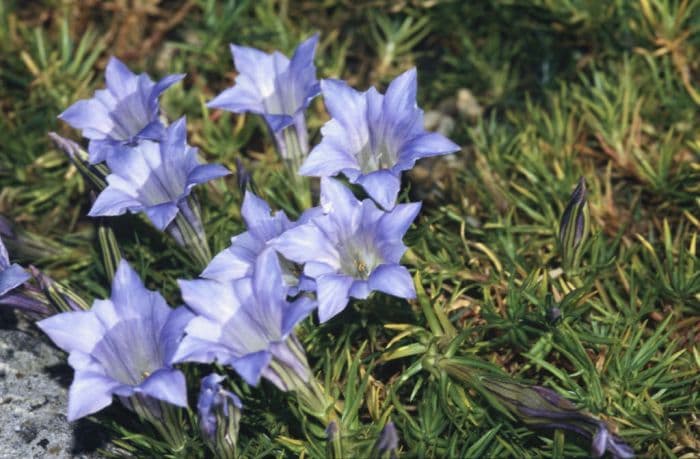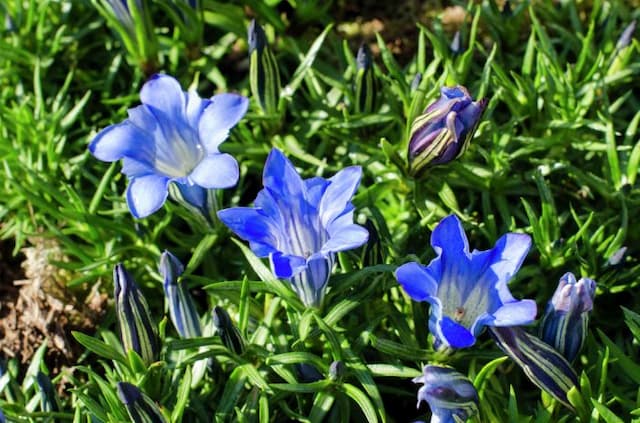Strathmore Gentian Gentiana 'Strathmore'

ABOUT
Gentiana 'Strathmore', commonly known as just Gentian, is a striking plant known for its vibrant, showy flowers. The blooms are the most distinctive feature, typically a deep blue or azure color, although they can occasionally boast shades of violet or purple. The trumpet-shaped flowers are large and funnel-formed, with flared tips that sometimes display delicate striping or spotting patterns. The foliage of Gentian 'Strathmore' is also quite attractive, with lance-shaped leaves that are arranged in opposing pairs along the stems. The leaves provide a lush green backdrop that further accentuates the intense blue of the Gentian flowers. The overall form of the plant is often neat and compact, making it a visually appealing addition to gardens. It’s worth noting that this plant has a clumping habit, and it blooms in late summer to early autumn, offering a splash of color when many other plants have finished flowering.
About this plant
 Names
NamesSynonyms
Strathmore Gentian
Common names
Gentiana 'Strathmore'
 Toxicity
ToxicityTo humans
The Gentiana 'Strathmore', commonly known as gentian, has no specific toxicity to humans. Generally, gentians are considered to have low toxicity and are sometimes used in herbal medicine. However, consuming any part of this plant is not advised unless it is under the guidance of a qualified professional, as inappropriate use can cause adverse effects.
To pets
Gentian does not have a widespread reputation for being toxic to pets, such as cats and dogs. However, individual animals may have sensitivities or allergies. As with any non-food plant, ingestion of gentian should be avoided to prevent potential gastrointestinal upset or an unexpected allergic reaction in pets. If you suspect your pet has ingested this plant and is showing symptoms of distress, consult a veterinarian.
 Characteristics
CharacteristicsLife cycle
Perennials
Foliage type
Deciduous
Color of leaves
Green
Flower color
Blue
Height
1-2 feet (30-60 cm)
Spread
1 foot (30 cm)
Plant type
Herb
Hardiness zones
Varies
Native area
Europe
Benefits
 General Benefits
General Benefits- Aesthetic appeal: Adds vibrant color and visual interest to gardens with its deep blue to violet trumpet-shaped flowers.
- Attracts pollinators: Invites bees and butterflies to the garden, which can help pollinate other plants.
- Low maintenance: Once established, requires minimal care and can thrive in poor soils, tolerating a degree of neglect.
- Cold hardiness: Can survive in cold climates, making it suitable for mountainous or northern gardens.
- Versatility in landscaping: Suitable for rock gardens, borders, or as a ground cover due to its mounding growth habit.
- Drought-tolerant: Once established, it has good resistance to drought, reducing the need for frequent watering.
- Non-invasive: Unlike some garden plants, it tends not to spread uncontrollably, which helps maintain garden design.
 Medical Properties
Medical PropertiesThis plant is not used for medical purposes.
 Air-purifying Qualities
Air-purifying QualitiesThis plant is not specifically known for air purifying qualities.
 Other Uses
Other Uses- Photography: With its vibrant blue flowers, Gentiana 'Strathmore' is often used as a subject in botanical photography and garden portfolios.
- Educational Tool: Botany classes and nature workshops use the plant to teach about alpine flora and pollination strategies.
- Cold Storage Indicator: In some cold storage facilities, the plant is used as a bioindicator for adequate temperature conditions necessary for storing certain perishables.
- Artistic Inspiration: Artists may use the striking appearance of Gentiana 'Strathmore' flowers as inspiration for paintings, sculptures, and other art forms.
- Textile Dyeing: The deep blue pigments of the flowers can be used in the natural dyeing of fabrics, yielding unique shades of blue.
- Culinary Garnish: In high-end gastronomy, the flowers may be used as an ornate, non-toxic garnish for dishes and desserts.
- Flower Arranging: Florists might incorporate Gentiana 'Strathmore' into floral arrangements for its height and distinctive color.
- Eco-Tourism Attraction: Gardens featuring this plant can become attractions, drawing in visitors interested in alpine plant species.
- Biodegradable Confetti: Dried petals of Gentiana 'Strathmore' can serve as a natural, biodegradable confetti for outdoor celebrations.
- Herbarium Specimens: The plant can be pressed and preserved as herbarium specimens for scientific study and historical record.
Interesting Facts
 Feng Shui
Feng ShuiThe Gentian is not used in Feng Shui practice.
 Zodiac Sign Compitability
Zodiac Sign CompitabilityThe Gentian is not used in astrology practice.
 Plant Symbolism
Plant Symbolism- Victory: Gentians, including the Gentiana 'Strathmore,' are often associated with triumph due to the fact that they thrive in harsh alpine environments, symbolizing overcoming challenges.
- Perseverance: This flower is a symbol of endurance and resilience, as it is known to bloom even under difficult circumstances, representing the idea of persisting despite obstacles.
- Strength: The robust nature of these plants, capable of surviving in rocky areas with high altitudes, reflects their symbolism of inner strength and fortitude.
 Water
WaterStrathmore Gentian prefers consistently moist soil, so it's important to water it regularly. During the growing season (spring and summer), water the Strathmore Gentian around once a week with approximately one gallon of water for a mature plant, adjusting for rainfall, to maintain moist soil. In the fall and winter, reduce watering to every two weeks or when the top inch of soil feels dry to the touch. Avoid overwatering, as this can lead to root rot.
 Light
LightStrathmore Gentian thrives best in full sun to partial shade conditions. Ideally, position the plant where it will receive morning sunlight and partial shade during the intense heat of the afternoon. This gentian variety can benefit from some protection from the hottest part of the day, so a spot that offers dappled sunlight can also be suitable.
 Temperature
TemperatureStrathmore Gentian is hardy and can generally tolerate temperatures ranging from 20°F to 80°F. The ideal temperature range for this plant is between 50°F and 70°F. It's crucial to avoid extreme heat or cold, as temperatures below 20°F or above 80°F could damage the plant or impede its growth.
 Pruning
PruningPruning Strathmore Gentian can encourage bushier growth and more vigorous blooms. Trim back dead or faded flowers throughout the blooming season to promote continuous flowering. In early spring, before new growth begins, prune back any dead or damaged stems to maintain the plant's shape and health. Pruning is typically done annually or as needed to remove dead foliage.
 Cleaning
CleaningAs needed
 Soil
SoilThe Strathmore gentian thrives in well-drained, loamy soil with a pH between 5 to 7. A mix of peat, loamy garden soil, and perlite can create an ideal environment, offering good aeration and moisture retention.
 Repotting
RepottingStrathmore gentian should generally be repotted every 1-2 years to refresh the soil and accommodate root growth. It's best done in spring before new growth starts.
 Humidity & Misting
Humidity & MistingThe Strathmore gentian prefers moderate to high humidity levels, around 50-70%, which mimics its native alpine environment.
 Suitable locations
Suitable locationsIndoor
Place in bright, indirect light and maintain cool temperatures.
Outdoor
Partial shade, sheltered spot, keep soil consistently moist.
Hardiness zone
4-7 USDA
 Life cycle
Life cycleThe Strathmore Gentian typically starts its life cycle as a seed, which, once sown in fertile, well-draining soil and with adequate chilling to break dormancy, will germinate and develop into a small rosette of basal leaves. As it matures, the plant then produces upright stems and elongated leaves during its vegetative growth phase, which occurs in spring to early summer. Following this, the Strathmore Gentian enters its flowering stage in mid to late summer, showcasing its distinctive trumpet-shaped, deep blue flowers that attract a variety of pollinators. After pollination, the flowers develop into fruit capsules containing numerous small seeds, which, when fully ripened, are dispersed by wind or other means. The plant then enters a period of dormancy in the fall and winter, conserving energy and surviving off stored nutrients until the next growing season. During dormancy, the above-ground part of the plant may die back, with the perennial root system surviving underground to sprout again once conditions are favorable.
 Propogation
PropogationPropogation time
Late Spring-Early Summer
Propogation: The Gentiana 'Strathmore', commonly known as the Gentian, is typically propagated by seed. The most popular method involves sowing seeds as this allows for the production of a large number of plants. To propagate Gentians by seed, one would usually sow the seeds in the fall, to allow for a natural stratification process which happens when seeds are exposed to the cold of winter, which in turn helps to break their dormancy. If a stratification period is needed outside of the natural season, seeds can be placed in a refrigerator for several weeks. Seeds should be sown in a well-draining soil mix, lightly covered with soil, and kept moist until germination, which can take several weeks to months. It's important to provide the seeds with cool temperatures and some shade to prevent them from drying out and to mimic the natural conditions they prefer for germination.




